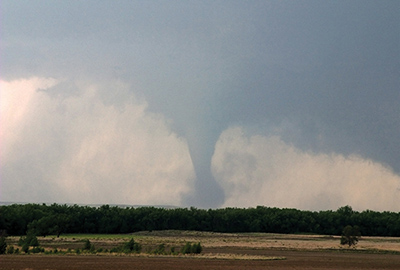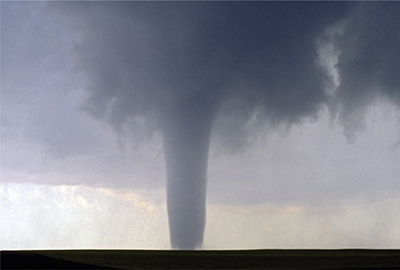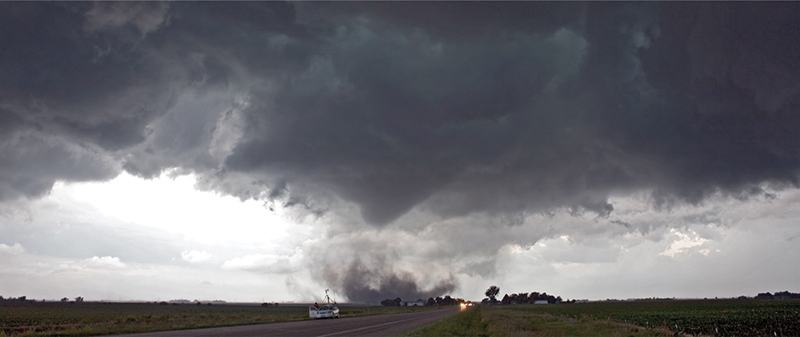With the RFD playing such a key role in the formation of a tornado, recognizing the horseshoe shape clear slot will greatly assist you in locating the most likely area from which a tornado may form.
Some circulations are first visible, near the supercell cloud base on the northside of the RFD. The RFD itself provides rapid accelerations usually dry, unstable air causing a tightening rotation.
Watch closely! The first sign of tornado development may be a dust whirl at the ground. If seen, closely examine this whirl to see if it is connected to the cloud base below a funnel cloud.
Potentially the strongest and most dangerous stage of the tornado's lifetime. The tornado's shape often has a near-vertical orientation.


There is nothing overly special about a visible funnel. The funnel forms as moisture condenses due to decreasing pressure in the tornado's vortex.
Therefore, with insufficient moisture, a visible funnel may not extend all the way to the ground and still have a mature tornado. Rotating debris and dust is evidence of a tornado.

With extremely unstable atmospheric conditions, where large tornadoes are possible, they can begin with several small satellite vortices orbiting around a larger main circulation. Occasionally these smaller vortices are seen briefly extending out from the side of the main circulation.
These are most dangerous storms as these smaller circulations tend to merge into the parent circulation and form very wide devastating tornados, called wedge tornado due to their mature shape.
The tornado begins to dissipate as the rear flank downdraft undercuts the surface circulation and to separate it from the warm buoyant air that it needs for its survival.
The tornado often begins to take on the shape of the RFD bulge which as it tilts the circulation. This is also referred to as the "rope" stage due to a snake-like appearance. Although the tornado is not as large as it was in the mature stage, it can still be dangerous.
With some atmospheric conditions, supercells will go through cycles themselves as the main updraft weakens and is replaced by the next updraft from the flanking line. This can allow for multiple tornados from the same parent storm.
This is different than one tornado with multiple small vortices spinning around a larger circulation. Cyclic supercells can have two (or more) full sized tornados in various stages of their life cycle.
Most of the time you will not know if a supercell will cycle again. Therefore, always be surveying the sky for any additional redevelopment of a new RFD and not solely focused on one tornado.
One clue to help assist you is to notice the wind flow. Does the wind continue to flow into the present tornado? Or, has the wind shifted direction and is now flowing into another portion of the storm, particularly to the south of the present tornado?
This shift in wind flowing into a new rainfree base south of the current tornado can be an indication of the supercell recycling.